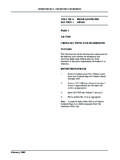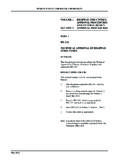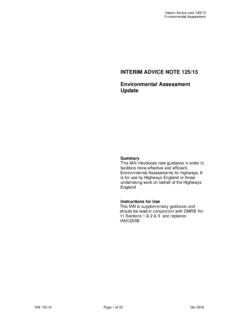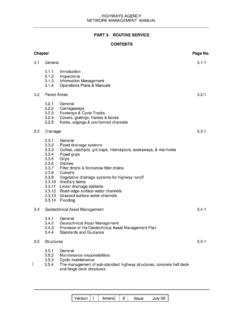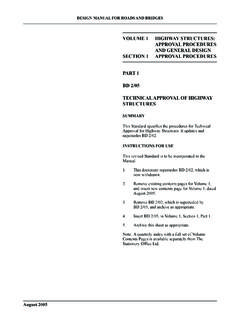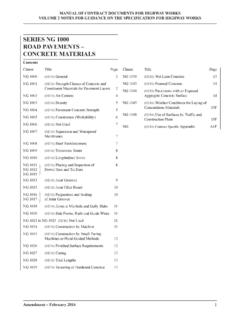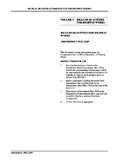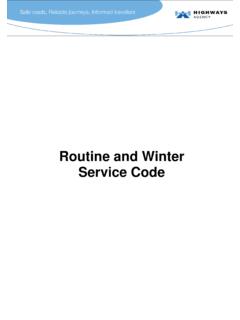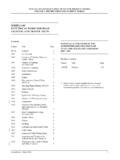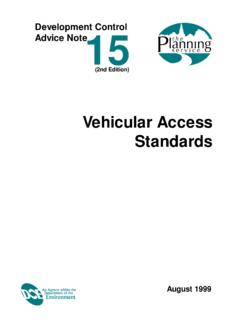Transcription of TA 57/87 - ROADSIDE FEATURES - Standards for …
1 ROADSIDE FeaturesSummary:This Advice Note gives recommendations on the location, use and layout ofcertain ROADSIDE FEATURES with regard to traffic operation and safety. It isapplicable to existing, new and improved rural HIGHWAYS AGENCYTA 57/87 THE SCOTTISH OFFICE DEVELOPMENT DEPARTMENTTHE WELSH OFFICEY SWYDDFA GYMREIGTHE DEPARTMENT OF THE ENVIRONMENTFOR NORTHERN IRELANDDESIGN MANUAL FOR ROADS AND BRIDGESELECTRONIC COPY - NOT FOR USE OUTSIDE THE AGENCYJ anuary 1989 PAPER COPIES OF THIS ELECTRONIC DOCUMENT ARE UNCONTROLLEDVOLUME 6 road GEOMETRYSECTION 3 HIGHWAYFEATURESTA 57/87 ROADSIDE FEATURESC ontentsIntroduction and for Facilities for Ridden FEATURES at Level of of 1 Lane Width ResrictionsAppendix 2 Pro-Forma for Rest Area / Picnic SitesAppendix 3 Lay-bys : ROADSIDE TradingVolume 6 Section 3TA 57/87 Introduction & ScopeELECTRONIC COPY - NOT FOR USE OUTSIDE THE AGENCYJ anuary 1989 PAPER COPIES OF THIS ELECTRONIC DOCUMENT ARE UNCONTROLLEDINTRODUCTION & SCOPEINTRODUCTIONIn 1968 the Ministry of Transport, in conjunction with the Scottish Development Department and the Welsh Officeproduced an advisory manual entitled 'Layout of Roads in Rural Areas' (LRRA).
2 It was to accompany the manual'Roads in Urban Areas' published previously (1966).Several major topics have been reviewed and updated by a series of Departmental Standards and Advice Notes notablyTD 9/81, TA 20/84, TA 42/84, TA 43/84, TD 16/84, TD 22/86, TA 48/86. These documents deal generally highwaylink and junction Advice Note supersedes and augments LRRA to cover those topics which have not already been superseded byother Departmental Standards for the improvement of the environment and safety on existing or new all-purpose trunkroads. Highway Authorities for other roads should find the advice contained is applicable in general circumstances andare encouraged to adopt the recommendations made. With the publication of this Advice Note TA 57/87 , LRRA becomes obsolete except for recommendations concerning the elimination of ROADSIDE hazards. It is the intention of theDepartment to deal with these in a separate Advice Note is applicable to both new and existing rural trunk roads.
3 In some circumstances the recommendationscan be adopted within urban areas, however there may be circumstances when reference to 'Roads and Traffic in UrbanAreas' (ref 1) may be more , cyclists and ridden horses have a right to pass along all-purpose roads. The particular requirements of thesehighway users should be provided for as part of the overall road design. Grade separation for pedestrians is not coveredand it is intended to give advice on this are made to related sources which should be consulted for comprehensive information on particular topics. Certain subjects, which have dispersed sources of information, are however covered in greater length within this 6 Section 3 Chapter 1TA 57/87 Kerbs and EdgingsELECTRONIC COPY - NOT FOR USE OUTSIDE THE AGENCYJ anuary 1989 PAPER COPIES OF THIS ELECTRONIC DOCUMENT ARE UNCONTROLLED1/11. KERBS AND In this section advice concerning the provision and placement of kerbs is given in general terms.
4 Featureswhich need to be considered or examined further are Kerbs accentuate the boundary between the carriageway and adjacent highway areas and can have animportant function concerning drainage or structural support of the carriageway. road markings and studs can incertain instances be used to delineate the edge of Urban all-purpose roads, urban motorways and slip roads are generally kerbed at all carriageway On rural all-purpose roads without adjacent footways, kerbs are not recommended other than in localised areasof particular drainage problems or in special cases where the road requires safety fencing or parapets such as onstructures or in tunnels. On major roads the edge treatment will generally be 1m hard strip marked with edge lines. On minor roads this strip may be reduced to Where kerbing is not provided on heavily trafficked roads which are unlit and have poor alignment, edgelining in accordance with table D of the Traffic Signs Manual (ref 2) should be Where extensive lengths of kerbing are to be placed then machine laid in situ concrete or asphalt upstandsplayed edgings may be considered; the latter being unsuitable where over-running is likely to take place.
5 Theassociated code of practice BS 5931 should be consulted on this topic (ref 3) when New or replacement concrete kerbs should be to British Standard 340 for standard sized and shaped concretekerbs and edgings; straight kerbs are recommended for use except where curves of 12m or less radii are to beconstructed (ref 4). Recent studies of accident rates and road characteristics (ref 5) on 350 kilometres of all-purpose dualcarriageways with speed limits of 60mph or more have shown by regression analysis that the presence of offsidekerbs is significant. Kerbed roads in the sample have higher accident probabilities which could not be explained byany other variable surveyed. Roads with offside metre strips were found to be safer but this may have resulted fromthe higher design Standards of modern roads with this edge KerbingWith Safety FencingWithout Safety Dropped A lowering of the kerb to the carriageway level to aid crossing by disabled persons (see section ), orcyclists (see section ), should be applied where private vehicular entrances, footpaths, and cycle tracks gainaccess to the carriageway.
6 If a water check is required this should be limited to about 12mm The minimum width of dropped kerb to serve Pelican & Zebra crossings should be Increased widths should be provided for each 125 pedestrians/hour over 600 up to maximum. Intermittently highpedestrian flows, such as at exits from large buildings, may require a greater width of dropped kerb to allowpedestrians to line up on the kerb without blocking the footway at controlled crossing Upstand KerbsChapter 1 Volume 6 Section 3 Kerbs and EdgingsTA 57/87 ELECTRONIC COPY - NOT FOR USE OUTSIDE THE AGENCYPAPER COPIES OF THIS ELECTRONIC DOCUMENT ARE UNCONTROLLEDJ anuary 19891 These are required universally in built-up areas and where the carriageway has an adjacent footway. Thesekerbs can give structural support to the adjacent footway or verge and make road channel sweeping more effective. Kerbs with full batter, splayed at 45 degrees, with around 100mm upstand above the carriageway, areappropriate for rural locations where a verge separates a footway from the carriageway and these can be used todemarcate traffic islands and Where footways are closer than metres from the carriageway half batter kerbs ( those with twelve-and-one-half-degree batter) are normally A kerb that is raised acts as a form of minor restraint to light traffic and can be usefully placed to reduce therisk of vehicles overrunning the verge.
7 Where flat verge overrunning takes place at rural junctions with corner radiiof 10m or less and without any adjacent footpath, raised kerbs may be Upstand kerbs are not generally recommended in rural areas without footways. Where positive vehiclerestraint is required, safety fencing (ref 6) or, exceptionally, barrier-type kerbing (see paragraph ) should beconsidered. Where kerbing may be required for positive drainage purposes on high-speed roads, the upstand shouldpreferably be 75mm and not exceeding 100mm. A vertical upstand kerbs should not be used in these circumstanceswithin 300mm of a running Flush These kerbs offer less danger of damage and offer little restraint to errant vehicles resulting from impact. They can serve as a means for defining the carriageway edge without requiring extra fill for adjacent verges and canbe useful in areas where considerable snow-ploughing may otherwise cause damage to raised In flat areas where it is impractical to artificially create longitudinal gradients for channels or drainage, flushkerbs can be employed to allow for continuous over-edge drainage of carriageway Rumble kerbs created by a serrated or ridged surface to the kerbing may be considered as one means ofalerting the drivers of errant vehicles.
8 The practice of placing granite sets into the carriageway, initially flush, across the mouth of minor roads atjunctions and at laybys, should be avoided wherever possible. These sets often become raised or polished and cancause a danger, particularly to cyclists and Where lay-bys are provided, kerbing should be located at the outside edge of the carriageway pavement. Inthe absence of existing ROADSIDE kerbing, the kerbing should start within the approach taper using a dropped kerb initially leading to half batter kerbing fully around the parking bay. The extent of kerbing beyond the parking baywill be affected by drainage and verge profile Where 1m hardstrips have been added to existing roads, kerbing sited within this strip has created severeaccidents involving cyclists and vehicles travelling in the hardstrip, and it is recommended that these sections ofkerb obstructing the metre strip should be removed and infilled to carriageway 6 Section 3 Chapter 1TA 57/87 Kerbs and EdgingsELECTRONIC COPY - NOT FOR USE OUTSIDE THE AGENCYJ anuary 1989 PAPER COPIES OF THIS ELECTRONIC DOCUMENT ARE UNCONTROLLED1 For type 1a lay-by (refer to section ) the raised dividing island should be provided either with profilededges on its approach nosing, or kerbed using half batter kerbs laid flat to form an incline rising 70-110m.
9 This willallow islands to be occasionally traversed by slow-moving vehicles without damage to wheels or suspension. Underpoor visibility or snow conditions, overrunning of the island is possible and therefore 45-degree batter kerb shouldbe provided on the outside of the dividing island adjacent to the metre At roundabouts, kerbing is recommended for the central island perimeter, the external edge of the circulatorycarriageway and all entries and exits. Attention is drawn to figure 6 of the Department Standard TA 42/84(Geometric Design of Roundabouts) (ref 7) concerning alignment of carriageways and relationship to edge lines Deflecting islands may have continuous raised kerbs except at the points where they are crossed by pedestrianroutes. Where there is serious risk of overrunning the island, such as at a layout with segregated left turn, and thedelineation cannot be adequately made by road markings, then splay kerbs should be considered to limit vehicledamage.
10 Kerbing on the central islands of roundabouts may be omitted where the layout fully complies with TD16/84 (ref 8) and TA 42/84 (ref 7). On roundabouts where approach speeds are limited to 55 kph, the use of 300mm upstand barrier-type safetykerbs can be particularly effective in preventing overrunning of footways by heavy vehicles. The use of this type ofbarrier kerbing is not recommended on high-speed roads and siting requires careful consideration to avoid thecreation of a potential Cycle Where cycle tracks join or cross carriageways, dropped kerb flush with the carriageway should be used ascarriageway edging. Concrete kerbing of 125 x 250 mm cross-section in conjunction with special dropped kerbs or450 x 250 mm quadrants are typical for urban areas. Edge kerbing around 50mm wide can be utilised to define boundaries where footpaths and cycle tracks areadjacent (see paragraph ) where there is a difference in level of between 50mm and Disabled Highway authorities are required under the Disabled Persons Act 1981 to have regard to disabled personswhen considering the provision of ramps at appropriate places between carriageway and footpaths.
